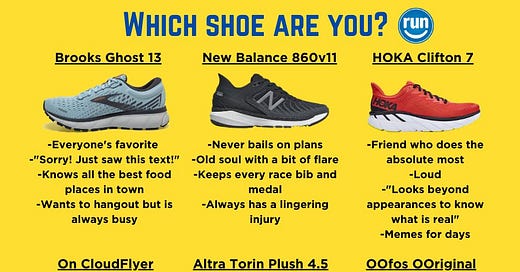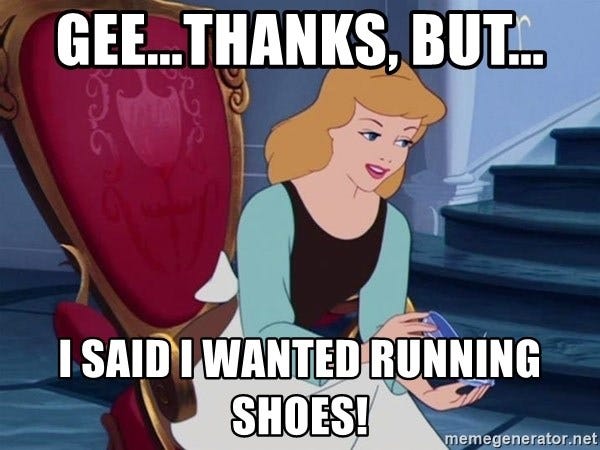LOLZLetter 185 | Mistakes You're Making With Your Running Shoes
Welcome,
This weekend was the ultimate lazy weekend for me. I did a race in a nearby town, but we didn't travel far and just relaxed. Some weekends you need that. I enjoy going places in Los Angeles or San Diego, but LA is 100 miles 1 way, and San Diego is 180 miles. So the drive can be exhausting. Anyway, I tell you to say sometimes staying home and resting is good. :)
So back to this week’s newsletter. On Wednesdays on Instagram, I ask if anyone has any shoe-related related questions. Last week someone asked what mistakes people who have been running for a while make with shoes...which inspired this newsletter.
What Running Shoe Mistakes Are You Making?
After working in a running store for 8+ years, I've seen many things, including people running in shoes that are three sizes too small or people running half marathons in converse or basketball shoes. Yes really. A big thing people also say is, "I need the most arch support ever.” You probably don't, but you do need a good running shoe. More support is not always better!
What Makes a Running Shoe A Running Shoe?
Have you ever wondered what the difference is between a $20 outlet Nike shoe and a $150 Nike running shoe? It's the quality of the materials.
The $20 shoe materials aren't made to withstand the impact of running. The materials in both shoes are entirely different, and the cheap shoe doesn't have the same support or cushion. The only thing the two shoes share is the same logo.
Just because you have an Asics, Saucony, New Balance, adidas, or Nike shoe doesn't mean it's a running shoe. Brands like Brooks and Hoka don't make cheaper knock-around shoes, so while you might not have the best shoe for your foot, at least you have a running shoe.
Here Are a Few Mistakes You Might Be Making:
Wrong Size:
If you think, "this could not possibly be me," think again. Ask yourself when was the last time you had your feet truly measured (including width and length).
Your feet change throughout your entire life. Women, your feet typically change after having children. If you wear the same size dress or casual shoes and running shoes, then chances are you're in the wrong size for one of them.
Your athletic shoes should always be your biggest shoe. You want to be able to wiggle your toes in your running shoes and have about a thumbnail width of space. Finally, like any other article of clothing, you don't wear the same size shoe in every brand. Brands all fit and run differently. Right now, I wear anything from a size 10-11 wide.
If your shoe is too small, you risk plantar fasciitis, neuromas, losing your toenails, or even stress fractures. If your shoe is a half size big, you don't run the risk of anything.
Wrong Width:
Many people have wide feet, and they don't even know it. Working in the running store, people were actually offended when I asked, "have you worn a wide before?" They are just feet. Who cares? Seriously how many people have you asked about their shoe size? If you have bunions, chances are you need a wide toe box, so your bunions don't get worse.
If a shoe is too narrow, you might get blisters, chafing, or holes on the side of your shoe (where your pinkie toe is or your bunions).
What about heal slippage from wide shoes? Many brands only widen the toe box because they know most people don't have wide heels. You aren't going to have many issues if your shoe is too long or wide...you will if your shoe is too narrow or short.
You're Wearing the Wrong Type of Shoe:
Many people think a running shoe is just a shoe. But you are going hundreds of miles walking, running, or whatever you’re doing. It's essential to have the correct fit and support for you. It's not about getting the most support; it’s about getting the right balance for your foot. Having too much support when you don't need it can cause issues like IT band syndrome or knee pain. Many people believe the more (support), the better, but that isn't true.
In contrast, many people do need support! You might develop issues such as knee pain or pain in the foot when you don't have enough support. There is no one perfect shoe for everyone (not even the Nike Alphafly). If there was an ideal shoe for everyone, there wouldn't be hundreds of brands and orthotics.
And no, not everyone needs orthotics, even if certain running stores say they made them custom to your foot.
Keep in mind that the support isn't in the shoe's sock liner. A sock liner doesn't protect anything; you could run in the shoe without it. Its job is to hide the stitching in the sole of the shoe. All of the support is in the midsole of the shoe.
Judge Your Feet Based on the "Paper Bag Test":
Many articles say to get your feet wet and stand on a paper bag. If you have high arches, get a neutral shoe. If you have flat feet, get a stability shoe. This isn't accurate unless you simply use the shoe for standing.
You need to know what your feet are doing in motion. There are plenty of people with flat feet, but they don't need any arch support because their ankles aren't moving. Similarly, many people with high arches collapse and need a stable shoe. Local running stores take into account what your foot does in motion. Don't buy running shoes solely based on the "paper bag test,” It will work for some people but not everyone.
Your Shoes Have Too Many Miles:
Running shoes are the most expensive "necessary" aspect of running, and it's understandable to try to get a "few extra miles out of the shoe."
But you should always remember a couple of essential points.
First, there is no exact amount of mileage you can get from any shoe. Some people can get 500+ miles; others can only get 200 in the same shoe. It doesn't matter your height or weight but how hard you are on the shoe. If your body feels fatigued and you haven't done anything differently, it's probably your shoes.
How you use the shoe: If you only run in your shoe, it will last longer. They break down much faster if you spend your whole day walking around in the shoe.
Stay with that size and shoe if you are 100% healthy and not losing toenails. It's boring, but it's better than being injured. You can get more mileage and save money by using the right shoes for you.
Getting refitted for shoes and seeing what is new is always worth your while. Your feet are constantly changing (think about it: You run 2000 miles in one year. That is a lot of wear and tear on your feet). But the running industry is constantly changing too. There might be something better that works for you.
What is Keeping Me Entertained?
Brooks Glycerin 20 Shoe Review
Brooks Glycerin 20 StealthFit Review
Marine Corps Marathon is looking for a new race director (this could be YOU!)
( Do You Need) Different Shoes for Different Terrains (a question I am asked often)
Things I'm enjoying this week:
I am adding a new section to the newsletter of things I'm enjoying for the week. It might be running related, and it might not.
Reebok Floatride Energy 4: My favorite daily trainer. I just had to retire it, but I will probably get a new pair. It's cheaper ($110) and a responsive neutral trainer.
Relay Active Clothing: A new brand that donates 1% of profits to animal charities. I ran my 5k in it on Saturday, and they are some of my favorite shorts to date.
M&M Cookie Sandwiches: I usually have ice cream most nights but I've been vibing with these cookie sandwiches lately.
If you enjoy the LOLZLetter, I appreciate you sharing it!
You Can Follow me on:







